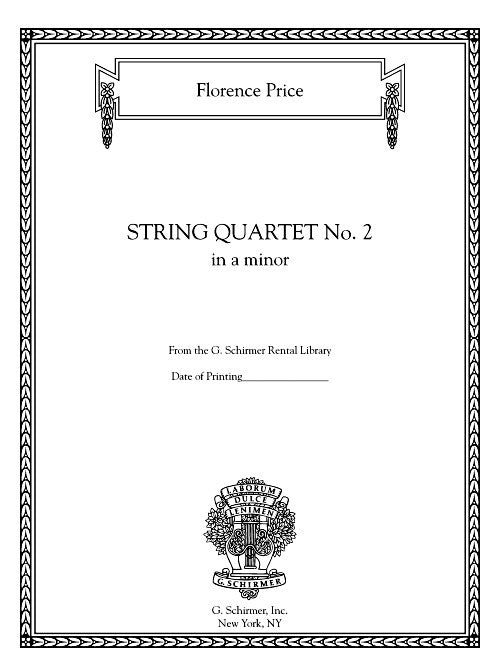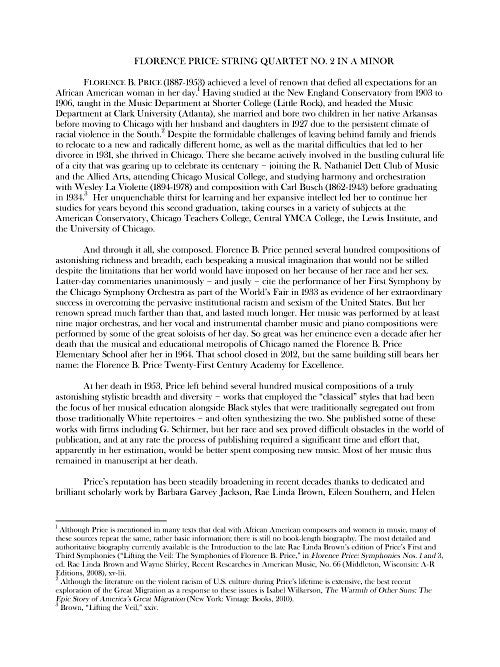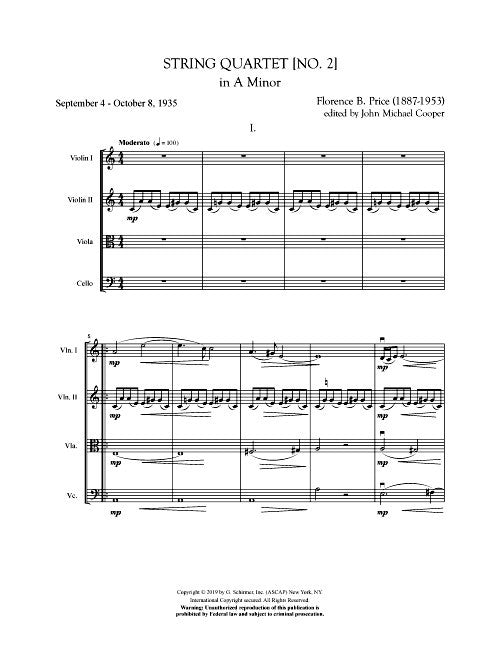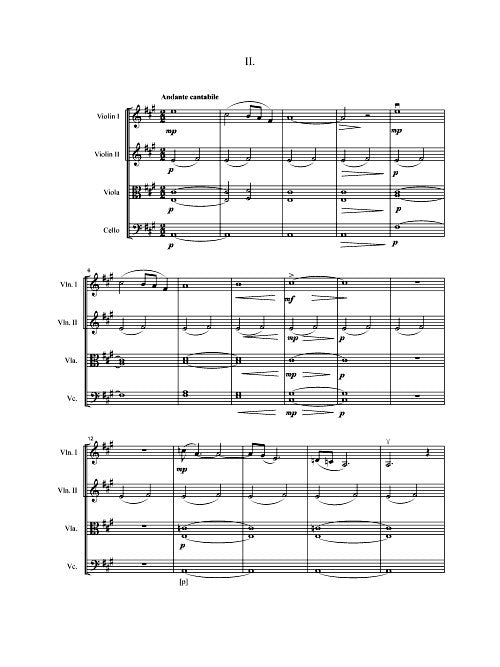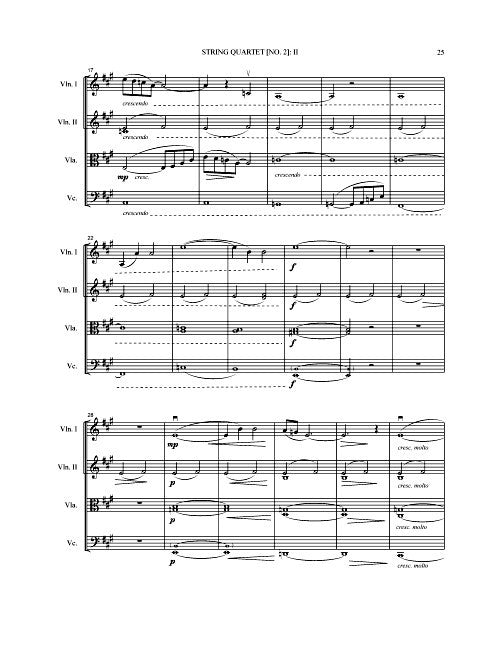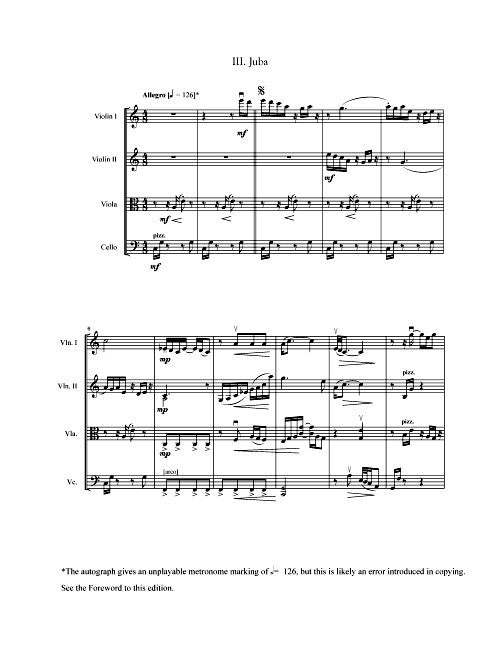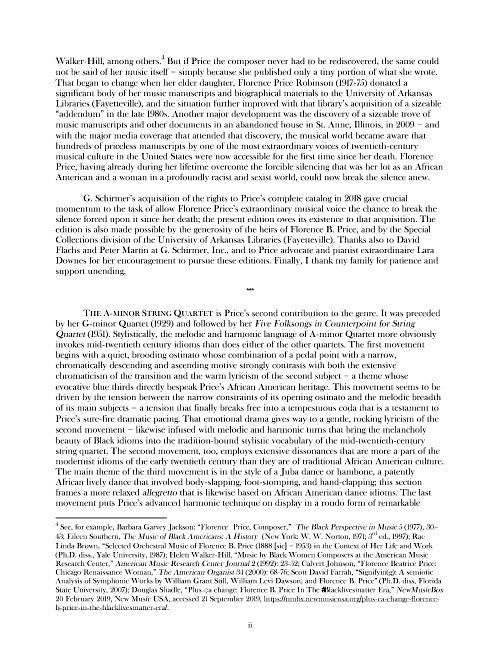Price: String Quartet No. 2 in A Minor
In stock and typically ships within 1 business day.
- Composer: Florence Price (1887-1953)
- Format: Score & Set of Parts
- Instrumentation: String Quartet (Violin I, Violin II, Viola, Cello)
- Work: String Quartet No. 2 in A Minor
- Size: 9.1 x 11.9 inches
Description
The A-Minor string quartet is Florence Price's second contribution to the genre. It was preceded by her G-Major quartet (1929) and followed by her Five Folksongs in Counterpoint for string quartet (1951). Stylistically, the melodic and harmonic language of A-Minor quartet more obviously invokes midtwentieth-century idioms than does either of the other quartets.
The first movement begins with a quiet, brooding ostinato whose combination of a pedal point with a narrow, chromatically descending and ascending motive strongly contrasts with both the extensive chromaticism of the transition and the warm lyricism of the second subject — a theme whose evocative blue thirds directly bespeak Price's African American heritage. This movement seems to be driven by the tension between the narrow constraints of its opening ostinato and the melodic breadth of its main subjects — a tension that finally breaks free into a tempestuous coda that is a testament to Price's sure-fire dramatic pacing. That emotional drama gives way to a gentle, rocking lyricism of the second movement — likewise infused with melodic and harmonic turns that bring the melancholy beauty of Black idioms into the tradition-bound stylistic vocabulary of the midtwentieth-century string quartet.
The second movement, too, employs extensive dissonances that are more a part of the modernist idioms of the early twentieth century than they are of traditional African American culture. The main theme of the third movement is in the style of a Juba dance or hambone, a patently African lively dance that involved body-slapping, foot-stomping, and hand-clapping; this section frames a more relaxed allegretto that is likewise based on African American dance idioms. The last movement puts Price's advanced harmonic technique on display in a rondo form of remarkable emotional breadth — a variety further emphasized by the searching, quasi-improvisatory Andantino featuring the solo viola, violin, and cello in mm. 120-35 and recast, abbreviated, as an interruption including the entire ensemble in mm. 187-92.
— John Michael Cooper
Publishers use a lot of words to describe what they sell, and we know it can be confusing. We've tried to be as clear as possible to make sure you get exactly what you are looking for. Below are descriptions of the terms that we use to describe the various formats that music often comes in.
Choral Score
A score for vocalists that only contains the vocal lines. The instrumental parts are not there for reference. Generally, cheaper than a vocal score and requires multiple copies for purchase.
Facsimile
Reproductions of the original hand-written scores from the composer.
Full Score
For ensemble music, this indicates that the edition contains all parts on a single system (there are not separate parts for each player). In larger ensembles, this is for the conductor.
Hardcover
Hardbound. Generally either linen-covered or half-leather.
Orchestral Parts
Similar to a wind set, this is a collection of parts. In the case of strings, the numbers listed are the number of copies included, though generally these are available individually (often with minimum quantities required).
Paperback
When publishers offer multiple bindings (e.g. hardcover) or study scores, this is the "standard" version. If you're planning to play the music, this is probably what you want.
Performance / Playing Score
A score of the music containing all parts on one system, intended for players to share. There are not separate parts for each player.
Set of Parts
For ensemble music, this indicates that there are separate individual parts for each player.
Solo Part with Piano Reduction
For solo pieces with orchestra, this is a version that contains a piano reduction of the orchestra parts. For piano pieces, two copies are typically needed for performance.
Study Score
A small (think choral size) copy of the complete score meant for studying, and not playing. They make great add-ons when learning concertos and small chamber works.
Vocal Score
A score prepared for vocalists that includes the piano/organ part or a reduction of the instrumental parts.
Wind Set
For orchestral music, this is a collection of wind and percussion parts. The specific quantities of each instrument are notated.
With Audio
In addition to the printed music, the edition contains recordings of the pieces. This may be an included CD, or access to files on the internet.
With / Without Fingering (Markings)
Some publishers prepare two copies - a pure Urtext edition that includes no fingering (or bowing) suggestions and a lightly edited version that includes a minimal number of editorial markings.
